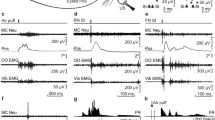Conclusions
-
1.
In experiments on waking, unimmobilized rabbits motor activity, evoked potentials, and unit activity in the visual and sensomotor areas of the neocortex were compared.
-
2.
Movements to flashes, reinforced by electric shocks, compared with orienting movements to the same stimulus developed after either a shorter or a longer (before reinforcement) latent period.
-
3.
The dynamics of involvement of the neurons in the response and the intensity of their discharge, in both the visual and sensomotor cortex, showed definite but dissimilar correlation in their general features with the temporal course of the amplitude of the evoked responses. The different surface-negative components of EP may be connected with either activation or inhibition of the majority of neurons.
-
4.
Activation of neurons in response to flashes (CS) begins simultaneously in the visual and sensomotor cortex about 20 msec after its beginning, and in the visual cortex it becomes weaker after 40–60 msec. In the sensomotor cortex the activity is maintained for a long time at a higher level.
-
5.
Movements in response to CS mostly begin after the end of the initial period of intensive discharge of the visual cortical neurons in response to flashes, against the background of moderate activation of these neurons, during the transition from an increased frequency of discharge to its inhibition or vice versa.
-
6.
Against the background of a deep inhibitory pause and intensive postinhibitory activation of the visual cortical neurons, the probability of movement beginning in response to CS is reduced.
-
7.
Activation of the sensomotor cortical neurons precedes and accompanies performance of the reflex to CS in both the early and the late stages of conditioning.
Similar content being viewed by others
Literature cited
Yu. I. Aleksandrov and V. B. Shvyrkov, Neirofiziologiya,6, No. 5, 551 (1974).
É. A. Asratyan, in: Current Problems in Physiological Science [in Russian], Nauka, Moscow (1971), p. 4.
U. G. Gasanov, Zh. Vyssh. Nerv. Deyat.,15, No. 4, 631 (1965).
U. G. Gasanov, Internal Inhibition [in Russian], Nauka, Moscow (1972).
E. R. John, in: Mechanisms of Formation and Inhibition of Conditioned Reflexes [in Russian], Nauka, Moscow (1973), p. 183.
I. N. Kondrat'eva, T. A. Korol'kova, G. I. Shul'gina, and G. A. Él'kina, Zh. Vyssh. Nerv. Deyat.,20, No. 5, 1000 (1970).
Yu. G. Kratin, Electrical Responses of the Brain to Inhibitory Stimuli [in Russian], Nauka, Leningrad (1967).
M. N. Livanov, Fiziol. Zh. SSSR,28, No. 2–3, 183 (1940).
M. N. Livanov, The Spatial Organization of Brain Processes [in Russian], Nauka, Moscow (1972).
M. N. Livanov and K. L. Polyakov, Izvest. Akad. Nauk SSSR, Ser. Biol., 286 (1945).
T. S. Naumova, Electrophysiological Analysis of the Mechanisms of Formation of the Conditioned Reflex [in Russian], Meditsina, Leningrad (1968).
V. B. Shvyrkov, in: Proceedings of Symposia of the 24th Conference of Problems in Higher Nervous Activity to Commemorate the 125th Anniversary of the Birth of I. P. Pavlov [in Russian], Moscow (1974), p. 7.
V. B. Shvyrkov and B. N. Bezdenezhnykh, Zh. Vyssh. Nerv. Deyat.,23, No. 1, 15 (1973).
V. B. Shvyrkov and S. V. Velichkina, in: Cybernetic Aspects in the Study of the Brain [in Russian], Nauka, Moscow (1970), p. 109.
G. I. Shul'gina, Zh. Vyssh. Nerv. Deyat.,l9, No. 5, 778 (1969).
G. I. Shul'gina, Zh. Vyssh. Nerv. Deyat.,26, No. 5, 962 (1976).
G. I. Shul'gina, in: Investigation of the Organization of Neuronal Activity in the Cerebral Cortex [in Russian], Nauka, Moscow (1971), p. 81.
G. I. Shul'gina, N. K. Oblacheva, and A. Kh. Lyapkusova, Zh. Vyssh. Nerv. Deyat.,22, No. 5, 1046 (1972).
V. Bonnet, Arch. Internat. Physiol. Biochem.,69, No. 5, 609 (1961).
F. Morrell, Physiol. Rev.,41, 443 (1961).
E. R. John, Ann. Rev. Physiol.,23, 451 (1961).
E. R. John, M. Shimokochi, and F. Bartlett, Science,164, 1534 (1969).
Author information
Authors and Affiliations
Additional information
Translated from Zhurnal Vysshei Nervnoi Deyatel'nosti im. I. P. Pavlova, Vol. 26, No. 6, pp. 1156–1164, November–December, 1976.
Rights and permissions
About this article
Cite this article
Shul'gina, G.I. Cortical evoked potentials and unit activity during conditioned reflexes. Neurosci Behav Physiol 8, 344–350 (1977). https://doi.org/10.1007/BF01182914
Received:
Issue Date:
DOI: https://doi.org/10.1007/BF01182914



